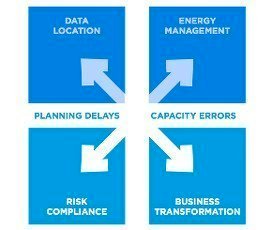CIOs hold fire over datacentre decisions
When it comes to devising datacentre strategies, are CIOs paralysed like rabbits in the headlights, or playing a calculated game of wait and see?
The majority of CIOs in Europe are finding it harder to devise datacentre strategies than a year ago, according to research from IT services company Colt.
Colt's survey of more than 500 enterprise IT infrastructure decision-makers in the UK, France, Germany and the Netherlands found that strategic and tactical datacentre planning is taking longer for 62% of respondents. A similar number (63%) said that in the past 12-24 months they had either underestimated or overestimated the amount of capacity they would require.
The research identified four main forces impeding CIOs’ ability to plan effectively for future datacentre needs: uncertainty over where to locate data; the challenges of risk and compliance; ongoing business transformation; and the need to better manage energy consumption.
The Four Forces of Data Centre Disruption report said: “In short, this combination of business issues serves to slow down datacentre strategy and responsiveness. This comes at a crucial time when data strategy needs to be as agile and dynamic as possible.”
More on datacentre planning
- Colt's Four Forces of Data Centre Disruption report
- Gartner's Web-Scale Singularity Means Goodbye to Conventional IT Wisdom report
- Get ready for the datacentre storm
- Netflix shows how to get cloud rolling
- Will open source save the datacentre industry?
- Why cloud's not reigning in the enterprise
- Dragon tells cloud business to focus on service
Matthew Gingell, Colt’s head of product and channel for datacentre services, said that while it came as little surprise that many organisations had misjudged capacity needs (since this has always been tricky to get right), he was more shocked to find decision cycles were getting longer.
“We like to think enterprises are becoming much more flexible and reactive, and everything’s getting quicker. Clearly that’s not happening,” he said. “The blizzard of all these different inputs in combination means that for many organisations decision-making is more difficult. There are so many different options out there, and so many things companies have to take into consideration.”
So are firms paralysed like rabbits in the headlights, or simply taking more time to assess their options in a bid to make better choices for the future?
"I suspect it’s more to do with education and knowledge. The fact 38% say their datacentre decision-making cycles are getting quicker shows that a sizeable minority have all the information they need to navigate their way through the various options. People delay decisions because of risk, and anything you can do to mitigate that risk will allow you to take decisions faster," said Gingell.
We like to think enterprises are becoming much more flexible and reactive, and everything’s getting quicker. Clearly that’s not happening
Matthew Gingell, Colt
‘Wait and see’ strategies no surprise to some
The range of options for planning datacentre capacity is expanding fast – among them modular datacentres, myriad flavours of cloud computing, and a raft colocation facilities and services. But, as Outsourcery CEO and BBC Dragon’s Den star Piers Linney pointed out at last week’s Cloud Expo Europe conference, the industry needs to do more to package these systems more effectively, in a way that addresses businesses’ key challenges with clearly defined service level agreements (SLAs)
It is likely that at least some of the organisations delaying decisions over datacentre investment are taking a calculated risk that the maturing market for more efficient datacentre and cloud solutions will present them with even more compelling options to improve their agility if they wait a little longer.
Earlier this year, Andy Lawrence, vice-president of research at industry analyst 451 Research, told Computer Weekly that he expected 2014 to be characterised by strategic planning rather than any rush to investment. "This year, there will be a lot more scrutiny and some genuine preparation for investment, but most of the actual investment will take place in 2015," he said.
Large cloud service providers are reinventing the way IT services can be delivered
Cameron Haight, Gartner
Another factor could be that larger organisations are eyeing the rapidly growing levels of datacentre efficiency being achieved by "web-scale" datacentre operators such as Amazon, eBay, Google and Facebook. According to a report released by analyst Gartner last month, by 2017 half of all large organisations will be using similar architectural approaches in their datacentres to these online giants.
"Large cloud service providers are reinventing the way IT services can be delivered," said Cameron Haight, research vice-president at Gartner. "Their capabilities go beyond scale in terms of sheer size to also include scale as it pertains to speed and agility. If organisations want to keep pace, they need to emulate the architectures, processes and practices of these exemplary cloud providers."
"Datacentres are designed with an industrial engineering perspective that looks for every opportunity to reduce cost and waste. This goes beyond redesigning facilities to be more energy efficient to include in-house design of key hardware components such as servers, storage and networks. Web-oriented architectures allow developers to build very flexible and resilient systems that recover from failure more quickly," he said.
But Colt’s Gingell maintains that the web-scale model is not appropriate for all large businesses. "The business should drive datacentre deployments, not the other way round. The fact there’s a shiny new Amazon, Google or Facebook datacentre out there is interesting, and it helps the industry develop, but it’s not right for everybody," he said.
"Many datacentre estates are getting old and need to be refurbished, others can be made more efficient. But the fact is a lot of these choices need to be made now – organisations can’t afford to put off the decision for very much longer."









